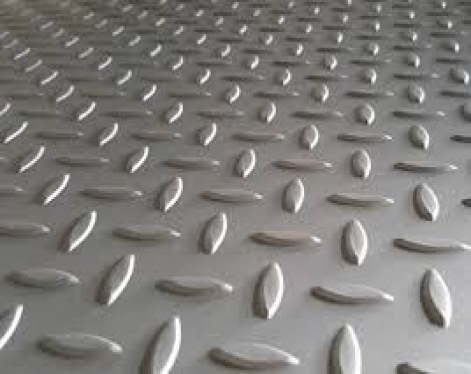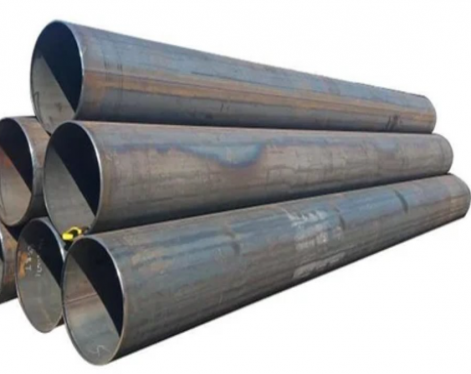According to the different materials used, checkered steel plates can be divided into stainless steel checkered plates, low-carbon checkered plates, and aluminum alloy checkered plates. This article mainly discusses the characteristics, applications, surface quality, and classification of mild steel checkered plate.
Mild steel checkered plate, simplified as MS Checked plate, also known as Mild Steel Diamond plate, is a type of metal sheets with a regular pattern of raised diamonds or lines made of hot rolled mild steel materials. The patterns of this metal plate are mainly diamond-shaped and lentil-shaped. It is mainly used in floors, factory escalators, work rack pedals, ship decks, car bottom plates, building facilities, mechanical equipment and other areas.
The steel plate is delivered in a hot-rolled state; there shall be no bubbles, scars, cracks, folds, inclusions, and stratification on the surface of the checkered steel plate.
The surface quality of patterned steel plate is divided into two levels:
(1) Ordinary precision: The surface of the steel plate is allowed to have a thin layer of iron oxide, rust, surface roughness caused by the shedding of iron oxide, and other local defects whose height or depth exceeds the allowable deviation. The pattern is allowed to have inconspicuous burrs and individual marks whose height does not exceed the height of the pattern. The maximum area of a single defect does not exceed the square of the pattern length.
(2) Higher precision: The surface of the steel plate is allowed to have a thin layer of iron oxide, rust, and other local defects whose height or depth does not exceed half of the thickness tolerance. The pattern is intact, and local slight burrs whose height does not exceed half of the thickness tolerance are allowed.

(1) Crystalline patterned steel: natural patterned steel, wootz steel/wootz, meteorite (black gold), top-quality rough patterned steel, top-quality wrought iron.
(2) Cast steel: made from pig iron and wrought iron, hundred-fold steel and crucible steel (cast steel)/cast iron.
(3) Spin-welded pattern steel: made from spin-welded embedded steel and spin-welded horse tooth clamp steel.
(4) Patterns produced by multiple passes of clamp steel and embedded steel forging.
(5) Ground steel: patterns produced by steel-wrapped soil-coated blade-burning technology.
(6) Folded steel: made from two or more steel or "iron" materials with different carbon contents that are repeatedly folded and forged.
(7) Filed steel: made by filing off the surface material of the blade of a sword that has already been clamped steel and forged flat. If properly controlled, this type of sword will have better patterns, be sharper, and have a certain degree of elasticity.
(8) Mechanically processed imitation Damascus steel pattern (patterned steel): Mechanically processed imitation Damascus steel is made by mechanically changing the welded steel layer, or synthesizing it through various procedures, mainly through twisting and then filing (cutting) to form patterned steel. Foreign powder Damascus steel is the best.
(9) Fusion patterned steel: The material is a variety of steels with different carbon contents. Patterns can be produced by industrial fusion, welding and other processes.
(10) Pickled patterned steel: It is made by uneven surface carburization.
According to the surface smoothness: it can be divided into flat pattern and rough surface pattern;According to the material, it can be divided into: cast crystal patterned steel and artificial forged (welded) patterned steel.
Mild steel checkered plate, simplified as MS Checked plate, also known as Mild Steel Diamond plate, is a type of metal sheets with a regular pattern of raised diamonds or lines made of hot rolled mild steel materials. The patterns of this metal plate are mainly diamond-shaped and lentil-shaped. It is mainly used in floors, factory escalators, work rack pedals, ship decks, car bottom plates, building facilities, mechanical equipment and other areas.
The steel plate is delivered in a hot-rolled state; there shall be no bubbles, scars, cracks, folds, inclusions, and stratification on the surface of the checkered steel plate.
1. Surface quality of tread plate
The surface quality of patterned steel plate is divided into two levels:(1) Ordinary precision: The surface of the steel plate is allowed to have a thin layer of iron oxide, rust, surface roughness caused by the shedding of iron oxide, and other local defects whose height or depth exceeds the allowable deviation. The pattern is allowed to have inconspicuous burrs and individual marks whose height does not exceed the height of the pattern. The maximum area of a single defect does not exceed the square of the pattern length.
(2) Higher precision: The surface of the steel plate is allowed to have a thin layer of iron oxide, rust, and other local defects whose height or depth does not exceed half of the thickness tolerance. The pattern is intact, and local slight burrs whose height does not exceed half of the thickness tolerance are allowed.

2. Classification of patterned steel
According to the process principle, patterned steel is roughly divided into the following common categories:(1) Crystalline patterned steel: natural patterned steel, wootz steel/wootz, meteorite (black gold), top-quality rough patterned steel, top-quality wrought iron.
(2) Cast steel: made from pig iron and wrought iron, hundred-fold steel and crucible steel (cast steel)/cast iron.
(3) Spin-welded pattern steel: made from spin-welded embedded steel and spin-welded horse tooth clamp steel.
(4) Patterns produced by multiple passes of clamp steel and embedded steel forging.
(5) Ground steel: patterns produced by steel-wrapped soil-coated blade-burning technology.
(6) Folded steel: made from two or more steel or "iron" materials with different carbon contents that are repeatedly folded and forged.
(7) Filed steel: made by filing off the surface material of the blade of a sword that has already been clamped steel and forged flat. If properly controlled, this type of sword will have better patterns, be sharper, and have a certain degree of elasticity.
(8) Mechanically processed imitation Damascus steel pattern (patterned steel): Mechanically processed imitation Damascus steel is made by mechanically changing the welded steel layer, or synthesizing it through various procedures, mainly through twisting and then filing (cutting) to form patterned steel. Foreign powder Damascus steel is the best.
(9) Fusion patterned steel: The material is a variety of steels with different carbon contents. Patterns can be produced by industrial fusion, welding and other processes.
(10) Pickled patterned steel: It is made by uneven surface carburization.
According to the surface smoothness: it can be divided into flat pattern and rough surface pattern;According to the material, it can be divided into: cast crystal patterned steel and artificial forged (welded) patterned steel.









